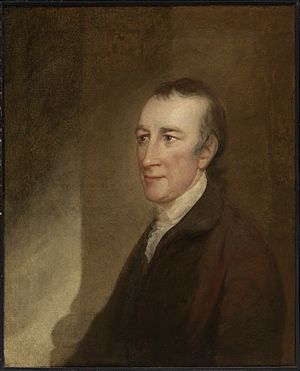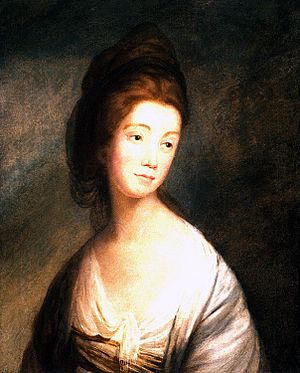Thomas Stone facts for kids
Quick facts for kids
Thomas Stone
|
|
|---|---|

Thomas Stone by Robert Edge Pine, c. 1785
|
|
| Member of the Maryland Senate | |
| In office 1781–1787 |
|
| In office 1777–1780 |
|
| Personal details | |
| Born | 1743 Charles County, Province of Maryland, British America |
| Died | October 5, 1787 (aged 43–44) Alexandria, Virginia, U.S. |
| Resting place | Thomas Stone National Historic Site |
| Relations | Michael Stone (brother) John Hoskins Stone (brother) Daniel of St. Thomas Jenifer (uncle) |
| Known for | Signer of the United States Declaration of Independence |
| Signature | |
Thomas Stone (1743 – October 5, 1787) was an important American leader. He was one of the Founding Fathers. He signed the United States Declaration of Independence for Maryland.
Thomas Stone was also a lawyer and a politician. He helped create the Articles of Confederation in 1777. This was an early set of rules for the United States. He also served in the Maryland Senate for many years.
Contents
Early Life and Learning
Thomas Stone was born in 1743 in Charles County, Maryland. His family was well-known in the area. He was the second of many children born to David and Elizabeth Jenifer Stone.
His brothers, Michael Jenifer Stone and John Hoskins Stone, also became important politicians. His uncle was Daniel of St. Thomas Jenifer. Thomas studied law in Annapolis. He became a lawyer in 1764 and started his own law office.
His Work for America
As the American Revolution began, Thomas Stone became involved. He joined a local committee in Charles County. From 1774 to 1776, he was part of Maryland's Annapolis Convention.
In 1775, he became a delegate to the Continental Congress. This was a meeting of representatives from the colonies. He was chosen again and attended these meetings for several years.
Voting for Independence
On May 15, 1776, Thomas Stone voted to write a declaration of independence. At first, Maryland's rules stopped its delegates from supporting independence. But in June, these rules were changed.
This meant Maryland's delegates could now vote for independence. Thomas Stone had hoped for a peaceful solution with Great Britain. He was a peaceful person and worried about a war. However, he eventually supported the idea of independence.
Family and Later Life
In 1776, Thomas Stone was part of the group that wrote the Articles of Confederation. During this time, his wife, Margaret, visited him in Philadelphia. The city had a smallpox outbreak.
Margaret got sick after a smallpox treatment. Her health got worse for the rest of her life. After signing the Declaration of Independence, Thomas took his wife home. He decided not to serve in Congress again, except for a short time in 1784.
Thomas Stone was elected to the Maryland Senate from 1779 to 1785. He wanted to help Maryland approve the Articles of Confederation. Maryland was the last state to agree to them.
He stopped practicing law to take care of his wife and children. As Margaret's health declined, he spent less time in public life. Margaret died in 1787. Thomas Stone became very sad and passed away less than four months later. He died in Alexandria, Virginia. People said he died of a "broken heart."
Thomas Stone was buried at his home, called Habre de Venture. His family owned the property for many years. In 1977, a fire badly damaged the main house. The National Park Service bought the property and restored it. Today, Habre de Venture is a museum. It is part of the Thomas Stone National Historic Site.
Personal Life
In 1768, Thomas Stone married Margaret Brown. She was the younger sister of Gustavus R. Brown. He was thought to be the richest man in the county. Soon after, Thomas Stone bought 400 acres of land. He began building his home, Habre de Venture.
Thomas and Margaret had three children: Margaret (born 1771), Mildred (born 1773), and Fredrik (born 1774). Thomas's law work kept him away from home. So, his younger brother Michael helped manage the plantation. The plantation used enslaved people for many generations.
Honors and Legacy
- A World War II ship, the SS Thomas Stone, was named after him.
- Thomas Stone High School in Charles County, Maryland is named in his honor.
- He is remembered at the Memorial to the 56 Signers of the Declaration of Independence.
See also
- William Stone – a relative who was a governor of the Maryland colony
- John Hoskins Stone – his brother, who also became a governor of Maryland
- Peggy Stewart House – a historic home in Annapolis, Maryland, once owned by Thomas Stone




